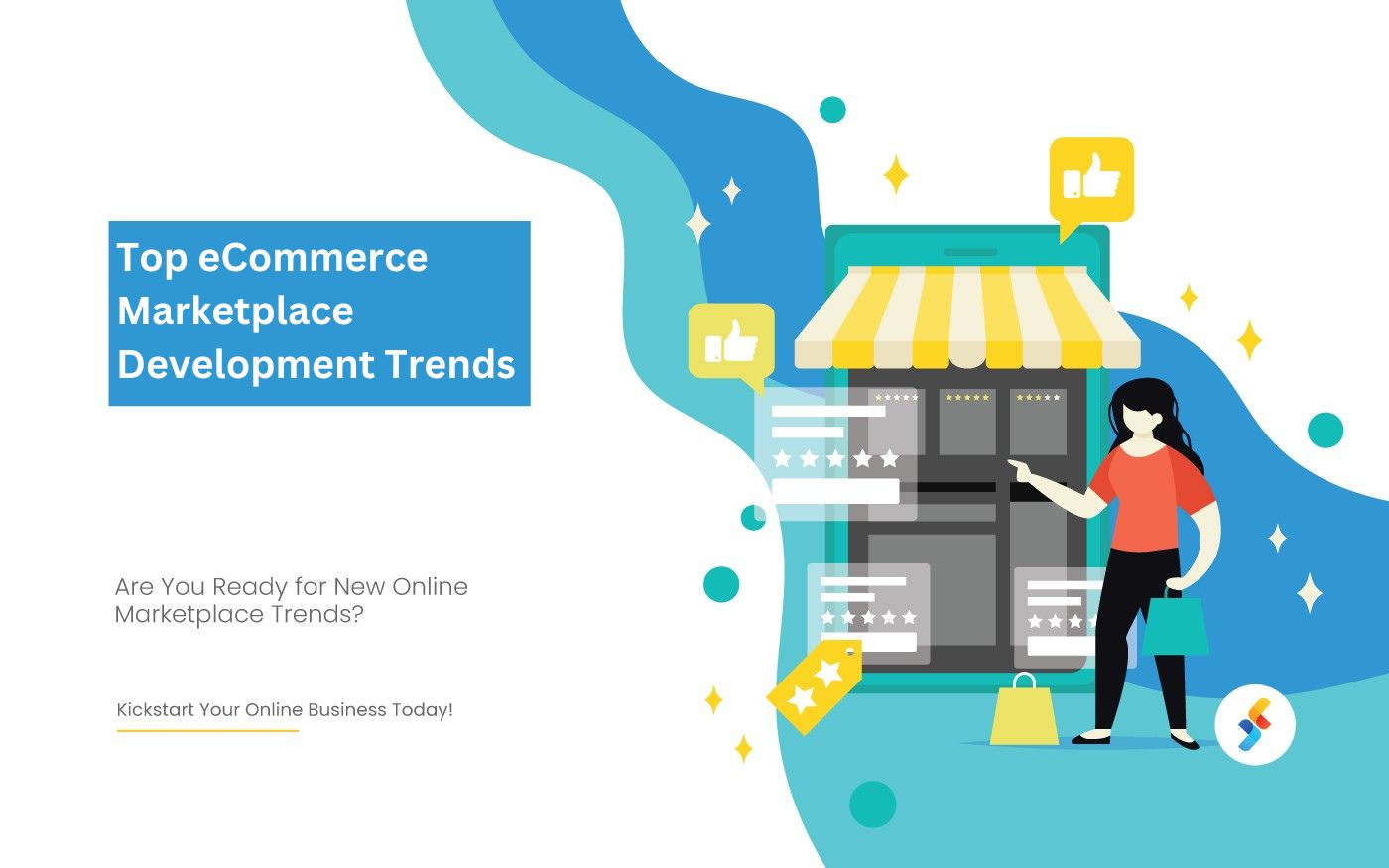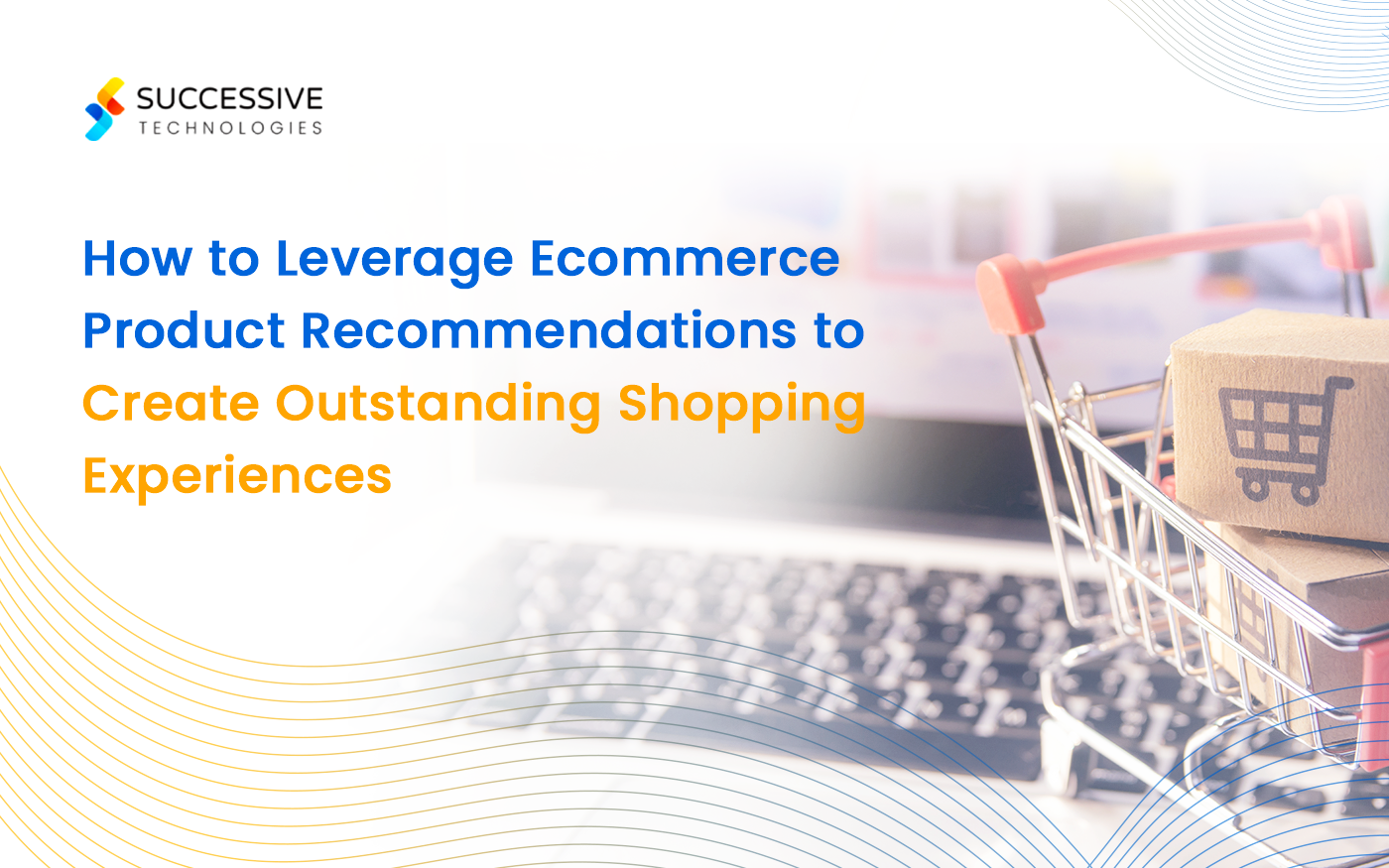When it comes to online shopping, customer expectations have evolved tremendously. Today, there is an increased demand for personalization, a seamless and omnichannel purchase journey, clutter-free and visually appealing shopping interfaces, and advanced search and navigation to zero in on the best products. The bottom line? Today’s customers gravitate to outstanding shopping experiences.
Many of these shopping experiences are enabled through the first digital touch-point for a customer – a website. Therefore, it’s vital for ecommerce businesses to deliver an outstanding website experience and meet the demands of customers, failing which, customers can simply move on and shop elsewhere.
Building an ecommerce website that leaves a lasting positive impression can be challenging and requires e-retailers to build and implement eCommerce website features that customers are bedazzled by, and those that enterprises can scale. So, which features are these?
Let’s dive in and have a look!
Comprehensive List of Must-Have Ecommerce Website Features
It’s easy to set up an eCommerce website – there’s readymade software that can help you build a digital store in hours or even minutes. But the real challenge is to build an eCommerce website that meets modern consumer demands, drives business growth, and is able to survive in a highly competitive landscape. One way to overcome this challenge is to enrich your ecommerce website with relevant features.
Here, we’ve consolidated ten industry-preferred front-end and back-end ecommerce website features that market leaders have leveraged to deliver exceptional user experiences.
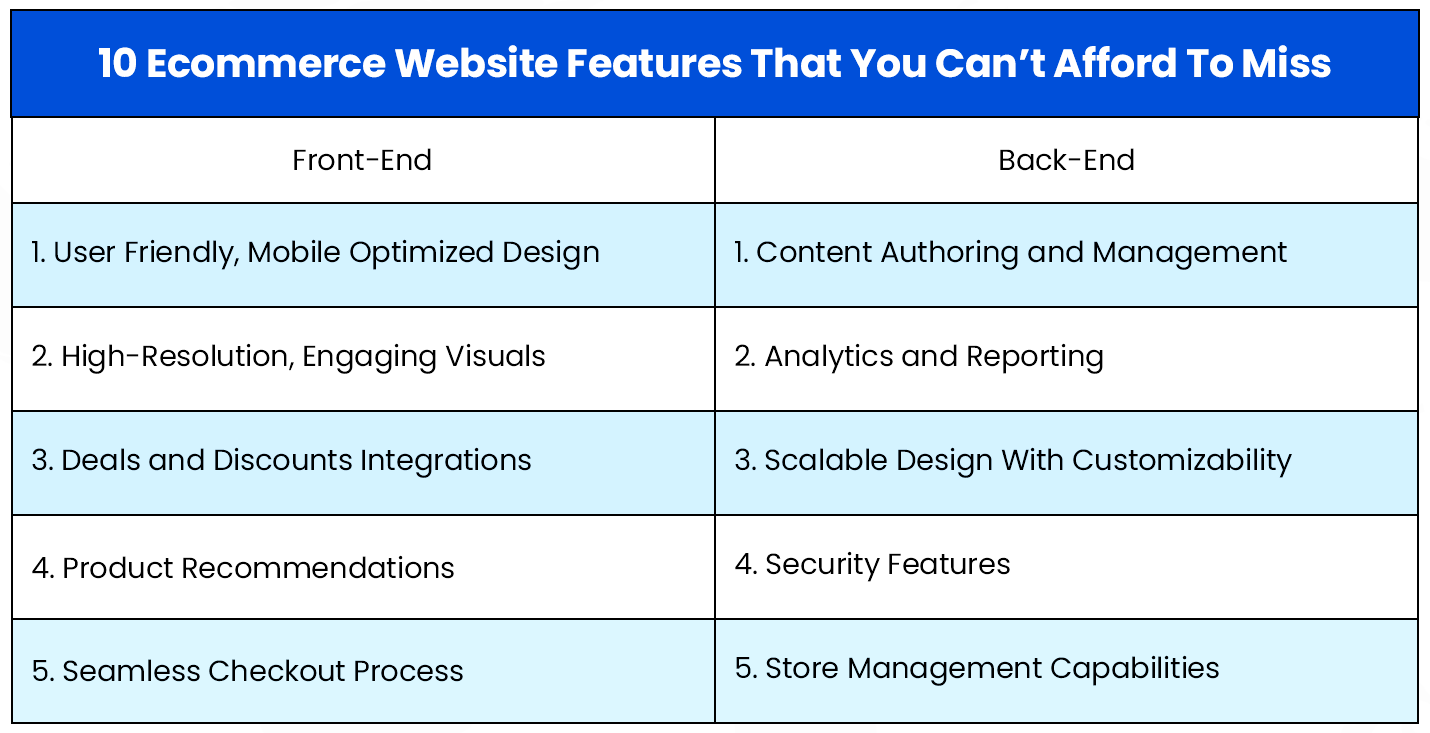
Let’s look at each of these eCommerce website features in more detail.
Front-End
Many eCommerce websites lean solely on good-looking and clean web design to attract visitors. However, what converts web visitors to customers is a seamless shopping experience, facilitated by great web usability. Here are five front-end eCommerce website features that can help your enterprise do this.
1. User-Friendly, Mobile Optimized Design With Effective Search and Navigation
A user-friendly interface is, arguably, the single most important feature that any ecommerce website must have – 50 percent of consumers believe that website design is crucial to a business’s brand, and 42 percent of consumers will leave a poorly designed website.
When it comes to improving the user-friendliness of an ecommerce website, some best practices include the following:
- Enabling searchability of products and categories to deliver precise results to customers’ queries
- Offering navigation features to help customers discover the right product in a vast ocean of inventory
- Optimizing the speed of the website with help from tools like Google’s PageSpeed Insights
- Streamlining the checkout and payments process using progress indicators, removing distractions, and providing clear information about costs, quantities, delivery dates, etc.
- Allowing customers to browse the digital store without forcing them to register
Further, given that mobile commerce accounts for 73 percent of ecommerce sales it’s important for enterprises to mobile-optimize their websites, or risk alienating customers.
Also Related: Embracing Mobile Commerce for Breakneck Growth
2. High-Resolution Visuals for an Engaging Shopping Experience
When customers shop online, their only references for what a product looks like are images and videos. High-quality visual elements can help close this huge gap between the actual physical product and its online representation.
When it comes to visuals, an important industry best practice is to showcase products from multiple angles. Some businesses take this to the next level by offering AR or VR views of their products, giving customers an immersive shopping experience.
Another important factor to consider is the optimization of images to improve page load speeds. E-retailers can make use of different image formats, dimensions and quality to ensure that customers gain a good understanding of what they’re purchasing before the product arrives at their doorstep.
3. Special Offers and Discounts to Capture Attention and Increase Conversions
It’s no secret that discount pricing can help ecommerce businesses gain and retain loyal customers. Businesses today are leveraging promotional offers to attract new customers, build customer loyalty, increase sales, and to even get rid of old inventory!
Using promotional campaign tools, ecommerce businesses can implement a discount pricing strategy that includes any one of or a combination of free shipping, buy-one-get-one-free, bundled discounts, seasonal and festive discounts, and volume discounts.
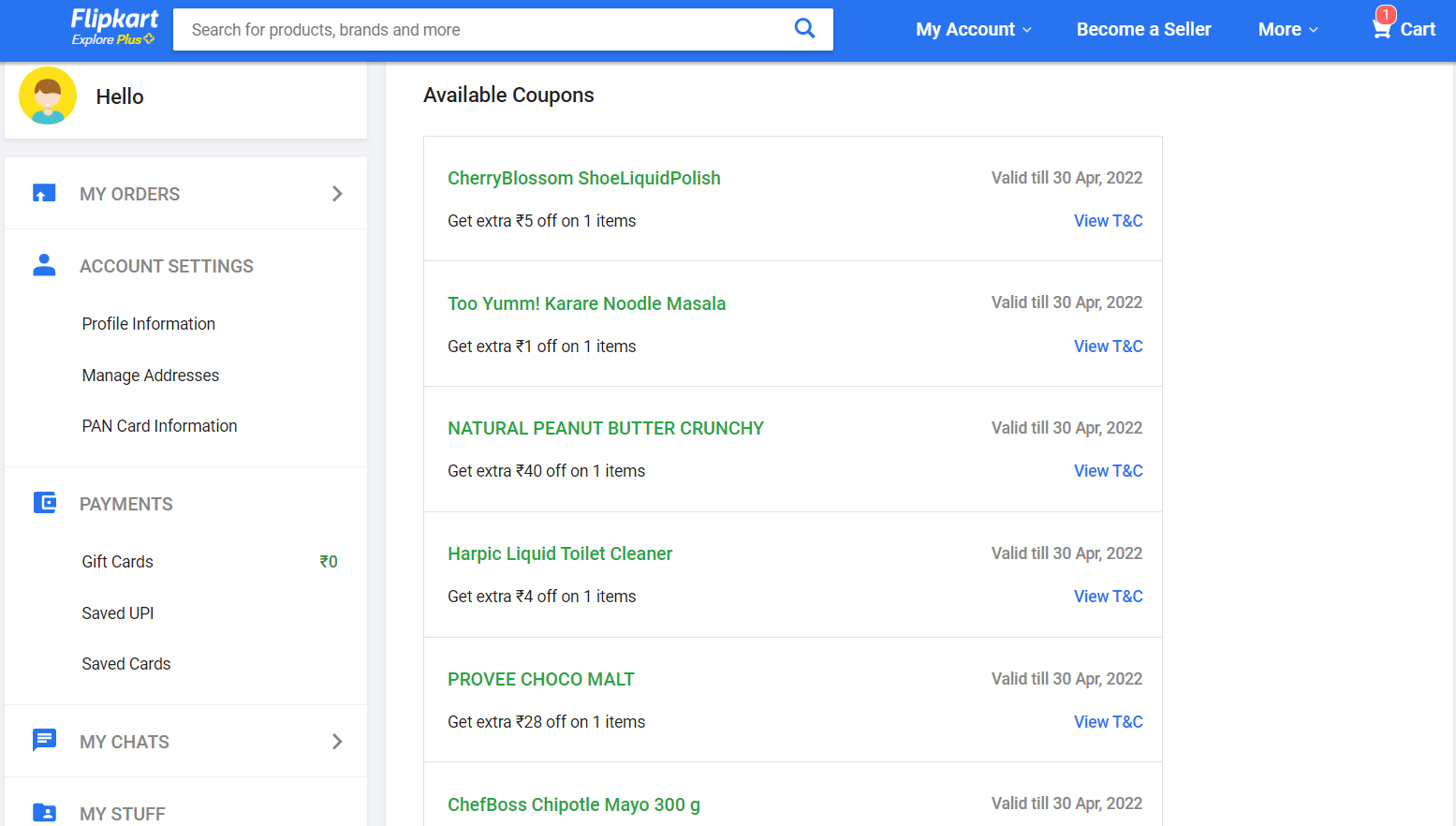
Coupons offered by Flipkart to a user on its website. (Source: Flipkart)
Your ecommerce website must also allow you to identify at what stage of the buyer’s journey will discount pricing be most impactful. Beyond alluring new customers with discounts, enterprises can offer discounted pricing in the following stages:
- When customers abandon their cart
- When customers show exit intent
- When customers subscribe to your emails or newsletters
4. Product Recommendations To Personalize Shopping Experiences
We cannot emphasize enough the importance of personalization in your customer experience strategy. Customers today want “Amazon-like” online shopping experiences, and one important way to deliver such an experience is through product recommendations.
Product recommendations make use of artificial intelligence and machine learning to generate relevant recommendations for customers. The impact? Customers are 4.5x more likely to add recommended products to their shopping cart, and an increase in the average order value.
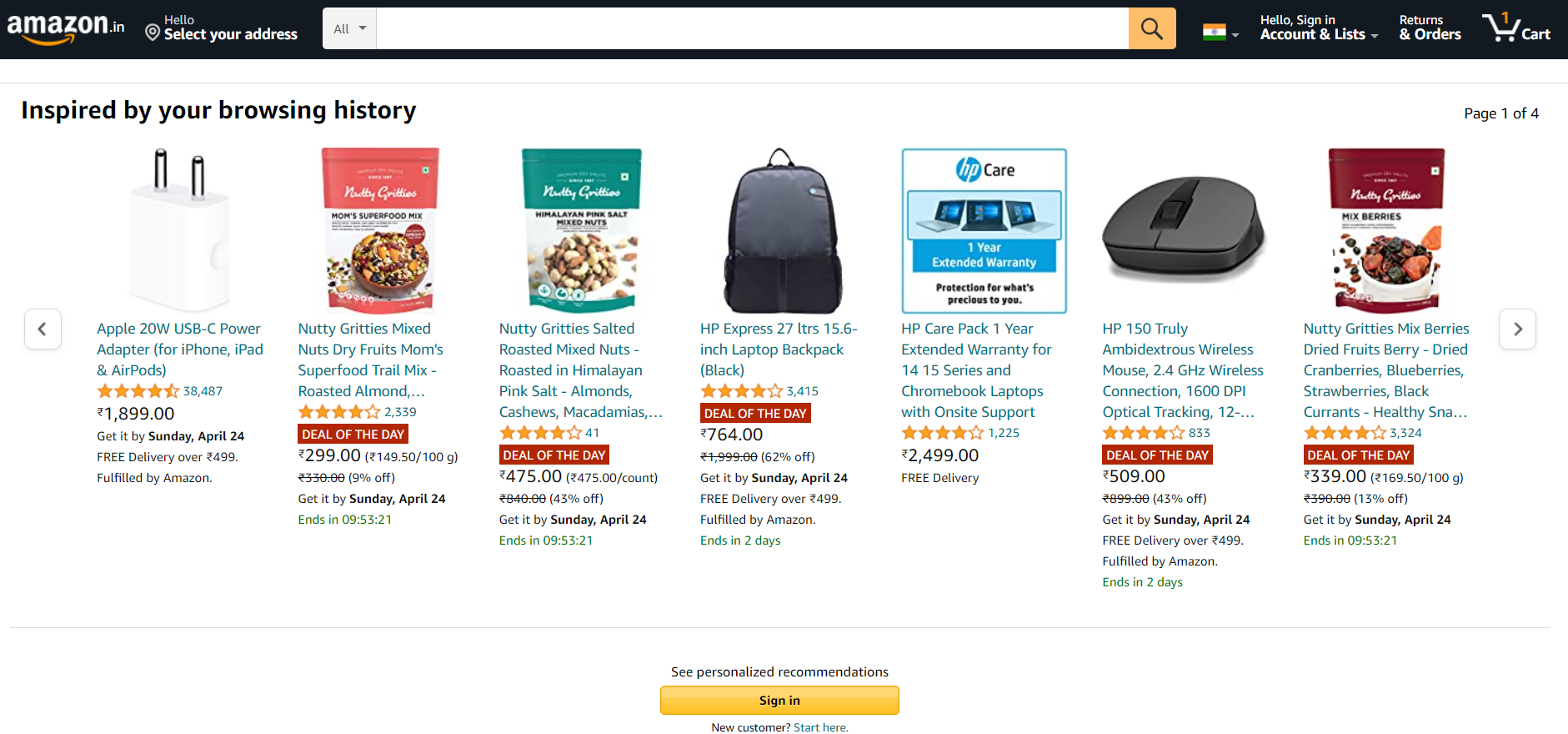
Product recommendations given by Amazon on its website. (Source: Amazon)
To reap the astonishing benefits of product recommendations, It’s important for ecommerce companies to formulate a recommendations framework – right from determining the technological resources and expertise required to build such a framework, to establishing where and how to display relevant recommendations on the website.
5. Intuitive Checkout Process With Multiple Payment Options
The checkout and payments stage of an online buyer’s journey is a tricky one – it’s very easy to lose a customer’s business at this delicate stage. The last thing you want is for the customer to be disoriented and discouraged by complexity. Here’s where payment gateways can be valuable.
Modern payment gateways don’t just offer a secure checkout experience but can also help make the process faster and significantly smoother. Payment gateways like PayU, PayPal, Razorpay, PayTM and many others also offer multiple payment and currency options so that customers can make quick payments regardless of how they’re paying or where they’re located.
Must Read: Creating Memorable E-Commerce Experiences with Cognitive Commerce
Backend
Much of an ecommerce website’s front-end features would be rendered useless without a robust backend – after all, the real magic happens behind the scenes! Here are five back-end ecommerce website features that can help you manage and scale user experiences!
1. Content Authoring and Management Capabilities
An ecommerce website with poorly structured content is a threat to your customer experience strategy. Not only will a website lacking relevant content be an obstacle to driving organic website traffic, but it will also dilute the on-site shopping experience for users. This is why your ecommerce website must have an integrated content management system (CMS).
A CMS can help boost organic web traffic, provide clear and valuable information about your website and products to customers, and improve the overall online shopping experience. A CMS can also become the core of your content marketing strategy, enabling you to create high-quality and timely content that drives engagement.
2. Analytics and Reporting Tools

If you’re not measuring, you’re not growing. This adage, applicable to businesses across industries, is vital for ecommerce businesses to imbibe. By setting key performance indicators (KPIs) and establishing business-critical metrics, enterprises can track the performance of their ecommerce website and make course corrections when needed. This is where analytics and reporting tools come in handy.
Your ecommerce website features must include analytics dashboard that generates valuable reports that facilitate intelligent and timely decision-making. Through tools like Google Analytics and dashboards provided by payment gateways, businesses can track key metrics and gain a data-driven understanding of how customers behave on their website, and which areas can be further optimized.
3. Scalable Application Design With The Ability To Add and Customize Features for your eCommerce website
As your business grows, your ecommerce website will need to scale as well to accommodate your fast-growing customer base that demands consistently delightful shopping experiences. At some stage, you may also need your ecommerce solution to manage multiple online stores and brands.
This is why it’s important to build or transform your ecommerce website into one that can support high order volumes and web traffic and has a reliable uptime.
Further, your ecommerce application must also be designed in such a way that you can easily add or eliminate features in the future.
Enterprises must plan ahead and factor in the scalability of their ecommerce website in their growth strategy, preparing for anything with a scalable ecommerce solution – an area of expertise for our team at Successive Digital.
4. Security Features for eCommerce Websites
Online transactions are susceptible to cybercrime. When a customer shops through your digital storefront, they’re sharing valuable financial and personal information that cybercriminals can steal and misuse unless you secure your website.
All websites, including and especially those facilitating ecommerce, must have security features and certifications that stand guard against cybercrime like phishing, SQL injection and cross-site scripting. These features include the following:
- A Secure Sockets Layer (SSL) or Transport Layer Security (TLS) digital security certificate to establish a secure connection between users and your website
- Two-factor authentication feature, adding a layer of security that requires authentication from the user before logging them in
- Digital firewall feature to manage permissions for traffic and prevent access to malicious web traffic
5. Store Management Features for eCommerce Websites
Store management features are very important to have for all ecommerce websites. These features allow businesses to easily manage products and their specifications – all of which are easily accessible and editable from the backend and require little to no developer effort. Some advanced store management capabilities include:
- Order processing and tracking
- Managing returns and refunds
- Managing customer inquiries and complaints
- Maintaining inventory
- Real-time and over-time analysis of revenue and order volumes
- Pinpointing new revenue opportunities
Today, many ecommerce platforms like WooCommerce, Shopify and Magento offer incredible store management capabilities, including ready-made software-as-a-service (SaaS) products that require no coding effort.
Also Related: The Key Ingredients of an Ideal Content Management System
Experiment With Ecommerce Website Features to Enable Outstanding Shopping Experiences
Every ecommerce site and its features will vary as per business requirements, and incorporating all features under the sun may not be what your enterprise really needs. Therefore, it’s important for businesses to experiment with features that can truly enhance customer experience, adding and eliminating features as per requirements.
It’s advisable to run feature experiments over a full business cycle to gain a holistic understanding of the feature’s impact on CX. Further, before stopping an experiment, enterprises must also consider the user’s average time to purchase, i.e., the time between a user’s first website visit and purchase event. This is because visitors who may enter the experiment towards its fag-end may not have enough time to complete a purchase before tracking stops.
Experimentation will be a great learning experience for eCommerce businesses and will encourage them to move away from cookie-cutter templates and build a scalable and unparalleled shopping experience!
Read Next: The 7 Secrets of E-commerce Giants – And What Can You Learn From Them?











